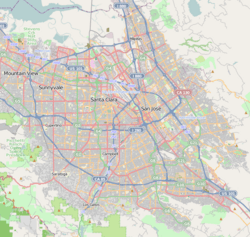Agnews Developmental Center facts for kids
Quick facts for kids |
|
|
Agnews Insane Asylum
|
|
 |
|
| Location | 4000 Lafayette St., Santa Clara, California |
|---|---|
| Built | 1906 |
| Architect | Stocking, Leonard, State Architect; Sellon & Hennings, McDougall, George |
| Architectural style | Mission Revival—Spanish Colonial Revival |
| NRHP reference No. | 97000829 |
| Added to NRHP | August 13, 1997 |
Agnews Developmental Center was a special place in California that helped people with mental health needs and developmental disabilities for many years. It had two main locations, one in Santa Clara, California and another in San Jose, California.
Contents
History of Agnews
Early Days and Purpose
The center first opened in 1885. It was called "The Great Asylum for the Insane." Its purpose was to care for people with mental health conditions. The main building was made of red brick. It was located near a place called Agnew's Village, which is now part of Santa Clara.
The building was designed by architect Theodore Lenzen. It followed a special plan called the Kirkbride Plan. This plan was a way to design hospitals for mental health care. By the early 1900s, Agnews was very large. It even had its own train station. This station helped people travel to and from the center.
Leadership and Change
A doctor named Frederick W. Hatch was in charge of Agnews from 1889 to 1897. He later became a leader for all state hospitals in California.
The 1906 Earthquake
A big earthquake hit San Francisco in 1906. It caused a lot of damage to Agnews and other nearby buildings. Sadly, 117 patients and staff members died. They were buried in special graves on the property. This earthquake caused the most deaths in the Santa Clara Valley area. After the earthquake, some people who were staying at Agnews escaped.
Rebuilding and Expansion
After the disaster, Agnews was rebuilt. The new buildings looked like a college campus. They were built in a style called Mission Revival—Spanish Colonial Revival. The center reopened around 1911. It was then called Agnews State Mental Hospital.
Agnews was like a small town on its own. It had many workshops and a farm. The farm raised pigs and grew vegetables. It also had its own power plant and even a fire department.
In 1926, Agnews grew even bigger. A second campus was added about 2 miles (3.2 km) away in San Jose. A hospital was later built there too. In 1965, the center started helping people with developmental disabilities. They had special programs to help them.
Changes in Care
In 1972, the programs for people with mental health conditions stopped. This was part of a change called "deinstitutionalisation." This meant that people started getting care in smaller places, not large hospitals. The west campus closed in 1998. The east campus continued to help people with developmental disabilities. It closed completely in 2011.
West Campus Closure
The original west campus closed in 1998. This was part of a plan to make the center smaller and eventually close it. When the west campus closed, there was a discussion about what to do with the land.
In 1997, the state decided to sell part of the land to Sun Microsystems. Sun Microsystems wanted to build its main offices and research center there. Some people thought it was wrong to sell public land to a big company. Others thought it was good to have a major technology company in the area.
There was also a discussion about saving the old Agnews buildings. Sun Microsystems agreed to fix up four historic buildings. These included the auditorium and the clock tower. They also agreed to let the public use some parts of the area. An outdoor exhibit now shares information and photos about the center's history. A small museum also opened near the cemetery.
Another part of the land became a new neighborhood called Rivermark. This area has homes, shops, a public school, and open spaces.
Agnews was added to the National Register of Historic Places in 1997. This means it is an important historical site.
Oracle Corporation bought Sun Microsystems in 2010. Part of the campus is still used by Oracle for research and meetings. In 2022, Oracle put 40% of the campus up for sale. Plans were suggested in 2024 to build homes on that part of the land.
East Campus Closure
In March 2009, the last patient moved out of the east campus. The living areas closed down. The east campus continued to offer some health services until April 2011.
In July 2011, the teams that helped patients moved to Campbell. They kept helping people in the local area.
The land for the east campus was sold. It was given to the California Department of General Services.
In July 2014, the City of San Jose and the Santa Clara Unified School District bought the property. They paid $80 million for it. They planned to build three schools and a city park. Demolition of the old buildings started in late 2018. Construction began soon after. The first two schools, Abram Agnew Elementary School and Dolores Huerta Middle School, opened in August 2021. The third school, Kathleen MacDonald High School, opened in 2022. The city park has not been built yet. The old hospital building is still standing. It is in a neglected and ruined state.
In Popular Media
Agnews Developmental Center has been used as a filming location.
- The 1984 film Birdy used the center.
- The 1989 horror film The Dead Pit was filmed at the east campus.
- The band Green Day filmed the music video for their 1994 song "Basket Case" at Agnews.





